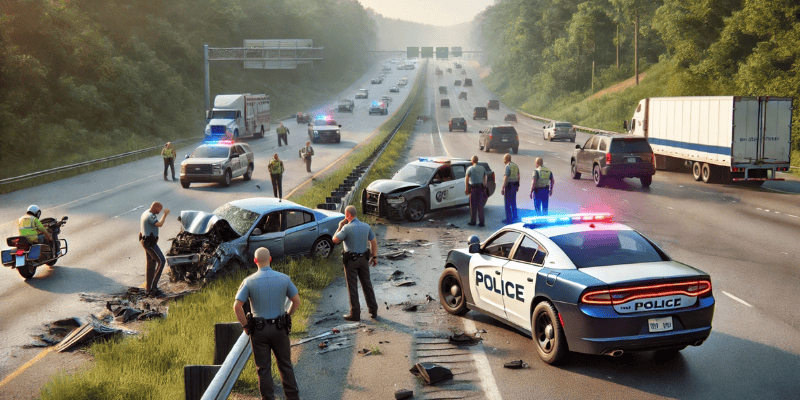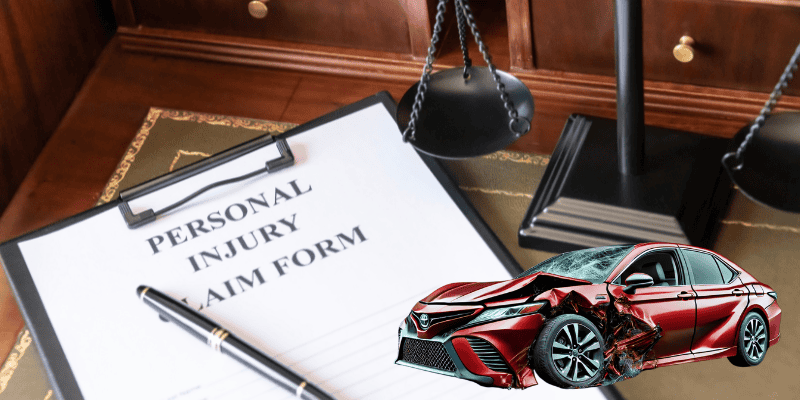4.9 Rating
Google REVIEWS
Leaders in Georgia Personal Injury Law Since 1995
Special SCRT Georgia Accident Reports for Motor Vehicle Accidents Involving a Death
If a Georgia car or truck accident results in the wrongful death of a driver, passenger, or bystander, a Georgia Motor Vehicle Accident Report is drafted by the investigating police officer, just like for any other accident.
However, when a fatality is involved, Georgia law requires that a supplemental accident report be drafted by specially trained officers. Sometimes these officers work for police departments, but rural areas and small cities may not possess the resources to staff a specially trained team. Usually, if a municipality does not have appropriate personnel, then the county will provide a team. If the county does not have a team, then another local jurisdiction can provide a team. If no local officers are qualified, then the Georgia State Patrol will investigate and draft the fatality accident report supplement.

SCRT Investigation Process
What do these specially trained officers do? Well, they perform a complete forensic investigation, including but not limited to: a) an evaluation of the collision dynamics; b) a mechanical inspection of the vehicles; c) a more thorough identification and interview process for drivers, passengers and witnesses; d) speed calculations; e) time and distance studies; f) crash data downloads from on board vehicle computers on tractor trailer rigs that have been involved in serious accidents; and g) computer animations. If you have ever driven in metro Atlanta or Gwinnett, Cobb or Dekalb Counties near major interstates, you know that if an accident has resulted in a death, that the entire road can be shut down for hours. These teams do their jobs carefully, regardless of the ambient chaos around them.
The most highly trained of these Georgia accident investigation teams are the Specialized Collision Reconstruction Teams of the Georgia State Patrol. SCRT units were authorized in 1997 after the Prosecuting Attorneys’ Council of Georgia demanded greater emphasis be placed on forensic examinations so that serious violators of Georgia’s traffic laws could be prosecuted and so Georgia DUI accident victims could obtain justice. SCRT officers receive over 1100 hours of comprehensive training in traffic accident investigation and reconstruction. Since January 1998, the SCRT units have conducted over 2000 fatal crash investigations. There are 5 SCRT teams in Georgia, spread out among the state so that they can cover all regions of Georgia quickly and efficiently.
Georgia Accident Reports and supplements for fatal car or truck accidents can be difficult to make sense of. Contact our Atlanta car accident attorney to obtain copies and discuss the contents with the investigating officers. The reports, including any SCRT Reports, should be available through the Georgia Open Records Act.
Initiation of SCRT Involvement
Criteria for SCRT Involvement in Accidents, Especially Those Involving a Death
The Specialized Collision Reconstruction Team (SCRT) is called to action primarily in situations where an auto accident results in serious injuries or fatalities. The decision to involve SCRT is typically based on the severity and complexity of the accident. Key criteria include:
- Fatalities: Any accident that results in a death automatically triggers SCRT involvement. The team’s expertise is crucial in accurately determining the sequence of events and contributing factors leading to the fatality.
- Serious Injuries: Accidents involving severe or life-threatening injuries may also prompt SCRT involvement, especially if there is potential for criminal charges, such as vehicular homicide.
- Multiple Vehicles or Complex Situations: Collisions involving multiple vehicles, commercial vehicles, or complex road conditions may necessitate the specialized skills of SCRT to untangle the events.
- Requests by Local Law Enforcement: Local law enforcement agencies can request SCRT assistance if the accident scene presents complexities beyond their standard investigative capabilities.
How SCRT is Notified and Dispatched to Accident Scenes
Once the criteria for SCRT involvement are met, the team is notified and dispatched through a coordinated system managed by the Georgia Department of Public Safety or the Georgia State Patrol (GSP). The process typically involves:
- Initial Notification: The first responding officers at the scene will assess the situation and determine if SCRT’s specialized skills are needed. They notify their command center, which then contacts SCRT.
- Dispatching the Team: Upon receiving the call, SCRT members, who are often on standby, are dispatched to the scene. They are usually equipped with specialized vehicles that contain the necessary tools and technology for thorough accident reconstruction.
- Coordination with Local Authorities: SCRT works closely with local law enforcement and emergency responders. They often take over the scene once they arrive, allowing them to preserve evidence and begin their investigation.

On-Scene Investigation
Detailed Steps Taken by SCRT Upon Arriving at an Accident Scene
When SCRT arrives at an accident scene, they follow a structured and methodical approach to ensure that every detail is captured accurately. The key steps include:
- Scene Securing and Initial Assessment: SCRT first secures the accident scene to prevent contamination or disturbance of evidence. This involves cordoning off the area and ensuring that all personnel involved are briefed on the procedures.
- Preliminary Observations: The team conducts an initial walk-through of the scene, taking note of the positions of vehicles, debris, skid marks, and any other visible evidence that could indicate the dynamics of the crash.
- Photographic Documentation: High-resolution photographs are taken from various angles to document the scene as it was found. This visual evidence is crucial for later analysis and court presentations.
- Measurement and Mapping: SCRT uses advanced tools, such as total stations or 3D laser scanners, to map the scene. These devices help create accurate, to-scale diagrams of the accident scene, capturing the exact positions of vehicles, skid marks, and other critical elements.
- Collection of Physical Evidence: Physical evidence, such as vehicle parts, road debris, and fluid samples, is meticulously collected. This evidence is often analyzed later to determine factors like vehicle speed, the angle of impact, and potential mechanical failures.
Use of Technology (e.g., 3D Mapping, Skid Mark Analysis) to Reconstruct the Accident
SCRT employs a range of sophisticated technologies to reconstruct the accident:
- 3D Laser Scanning: This technology allows SCRT to create a detailed, three-dimensional model of the accident scene. The model can be rotated, zoomed, and examined from multiple perspectives, providing a comprehensive view of the crash dynamics.
- Skid Mark Analysis: Skid marks are analyzed to determine the speed of the vehicles at the time of braking, the direction of travel, and whether evasive maneuvers were attempted. This analysis can reveal critical details about driver behavior just before the collision.
- Event Data Recorders (EDRs): If the vehicles involved are equipped with EDRs, SCRT can retrieve data on speed, braking, steering input, and other parameters that occurred in the moments leading up to the crash. This data is crucial in establishing a timeline of events.
Post-Scene Analysis
Description of the Analysis Conducted After Leaving the Scene
After collecting all necessary data from the scene, SCRT performs a detailed analysis in a controlled environment. This analysis typically involves:
- Reconstruction of the Accident Sequence: Using the data and evidence collected, SCRT reconstructs the sequence of events that led to the accident. This reconstruction is based on principles of physics, vehicle dynamics, and human factors.
- Vehicle Examination: The vehicles involved in the accident are often brought to a secure location where SCRT conducts a thorough examination. This includes checking for mechanical failures, examining tire wear, and analyzing damage patterns to determine the forces involved in the collision.
- Analysis of Environmental Factors: Road conditions, weather, and lighting at the time of the accident are analyzed to understand their potential impact on the accident. This includes reviewing weather reports, examining the road surface for irregularities, and considering visibility factors.
- Witness Statements and Corroboration: Witness statements collected at the scene are cross-referenced with physical evidence and the reconstructed model of the accident. Discrepancies are carefully examined to piece together the most accurate account of events.
How SCRT Evaluates Evidence (e.g., Vehicle Damage, Road Conditions, Witness Statements)
SCRT evaluates evidence through a meticulous and systematic approach:
- Vehicle Damage Analysis: The extent and nature of damage to the vehicles involved are analyzed to understand the impact forces, points of contact, and whether the damage aligns with the reported sequence of events.
- Road Conditions: SCRT examines the road for factors that could have contributed to the accident, such as potholes, oil spills, or worn-out road markings. They also consider the grade of the road, curvature, and whether road signage was adequate and visible.
- Witness Statements: Witness statements are critically analyzed for consistency and compared with physical evidence. SCRT uses these statements to fill in gaps that the physical evidence alone might not explain.

Report Compilation
How Findings Are Compiled into a Comprehensive SCRT Report
After completing the analysis, SCRT compiles their findings into a detailed report. The process includes:
- Organizing Data and Evidence: All data, photographs, physical evidence, and analysis results are organized in a logical sequence. The report begins with an overview of the incident, followed by detailed findings.
- Incorporation of Diagrams and Models: The report includes diagrams, such as to-scale maps of the scene, and 3D models that visually represent the accident. These visuals help clarify the narrative and support the technical findings.
- Technical Analysis and Calculations: The report provides technical analysis, including calculations of vehicle speeds, angles of impact, and forces involved. These calculations are based on established principles of physics and engineering.
- Narrative Summary: A narrative summary outlines the sequence of events as reconstructed by SCRT. This section ties together the physical evidence, witness statements, and analysis to present a coherent account of the accident.
Elements Included in the Report (e.g., Diagrams, Speed Calculations, Impact Analysis)
A comprehensive SCRT report typically includes:
- Accident Scene Diagrams: Detailed diagrams showing the layout of the accident scene, including the positions of vehicles, skid marks, and other critical evidence.
- 3D Models: If applicable, 3D models created from laser scanning are included to provide a dynamic view of the accident scenario.
- Speed and Impact Calculations: Calculations of the speeds of the vehicles involved at various points, along with the forces generated during impact.
- Vehicle Damage Assessment: A detailed assessment of the damage to each vehicle, including diagrams showing points of impact and deformation.
- Environmental Analysis: A summary of the environmental conditions at the time of the accident, including road conditions, weather, and visibility factors.
- Witness Statement Analysis: An evaluation of witness statements, highlighting how they align with or differ from the physical evidence.
- Conclusions and Recommendations: The report concludes with SCRT’s professional opinion on the cause of the accident and any contributing factors. Recommendations for improving road safety or preventing similar accidents in the future may also be included.

The Georgia Open Records Act
The Georgia Open Records Act (O.C.G.A. § 50-18-70) is a state law that ensures public access to government records, including those related to auto accidents. This law is based on the principle of transparency, allowing the public to request and obtain records from state and local government agencies.
Key Points on the Georgia Open Records Act as it Pertains to Auto Accidents:
- Access to Accident Reports:
- Under the Georgia Open Records Act, individuals involved in auto accidents, their attorneys, and other authorized parties can request copies of accident reports from law enforcement agencies. These reports typically contain essential details about the accident, including the names of the parties involved, the location, and the circumstances surrounding the incident.
- Accident reports are usually available after the law enforcement agency has completed its investigation and filed the report. The process to request these records can vary depending on the agency, but generally involves submitting a written request, sometimes accompanied by a small fee.
- Exemptions and Redactions:
- While the Georgia Open Records Act promotes transparency, there are certain exemptions that protect sensitive information. For example, personal information such as social security numbers, medical information, and other sensitive data may be redacted (blacked out) before the records are released to protect privacy.
- Additionally, ongoing investigations may temporarily shield some records from public disclosure until the investigation is complete, ensuring that the release of information does not interfere with law enforcement activities.
- Usage in Legal Cases:
- Accident reports obtained under the Georgia Open Records Act can be crucial in legal cases, particularly in personal injury claims. These reports provide a factual account of the accident, which can be used as evidence in court or during settlement negotiations.
- Attorneys often use these reports to build a case, determine fault, and negotiate with insurance companies. The detailed information within these reports can help in establishing the cause of the accident and the extent of the damages.
- Timeliness of Requests:
- The Act requires that government agencies respond to open records requests within a reasonable time, usually within three business days. If the requested records cannot be provided within this timeframe, the agency must inform the requester when the records will be available and the cost, if any, associated with retrieving them.
- Impact on Insurance Claims:
- Insurance companies also rely on accident reports to assess claims. Accessing these reports through the Georgia Open Records Act helps insurers determine liability and the appropriate compensation for damages.

Conclusion:
The Georgia Open Records Act plays a significant role in providing access to auto accident records, facilitating transparency and fairness in the handling of these incidents. Whether for legal proceedings, insurance claims, or personal records, the Act ensures that the public can obtain the information they need while balancing the protection of sensitive data.
Like any accident report, time is of the essence when mistakes are made. Mistakes can become “facts” if not corrected. Be diligent in obtaining and reviewing a report should a tragedy occur.
